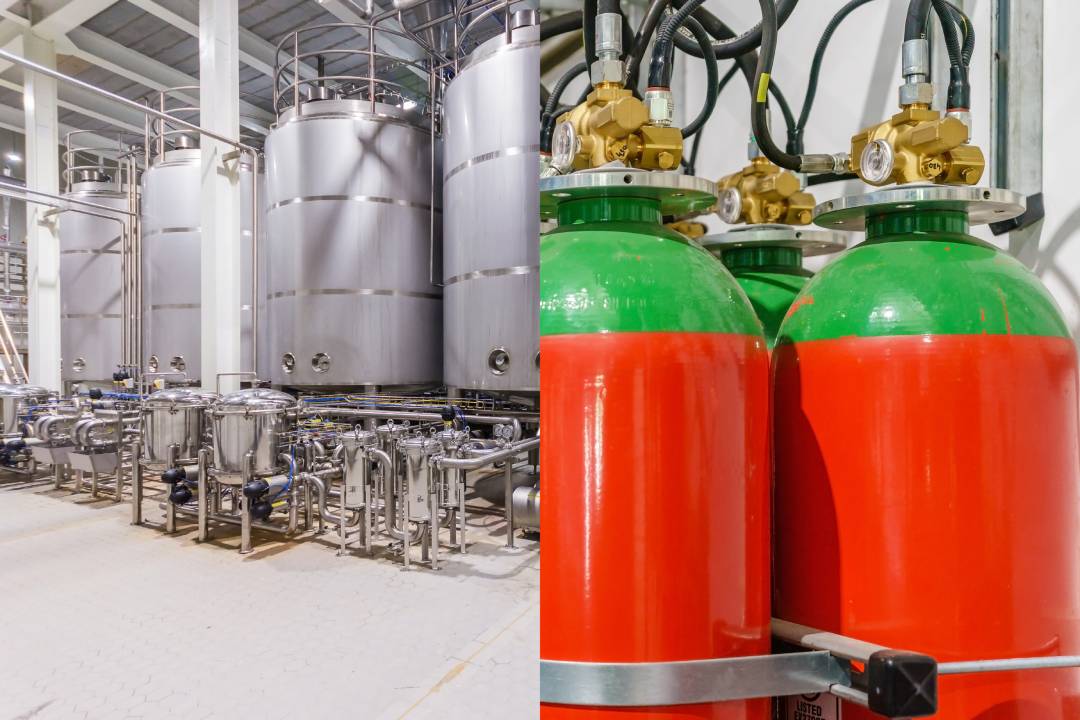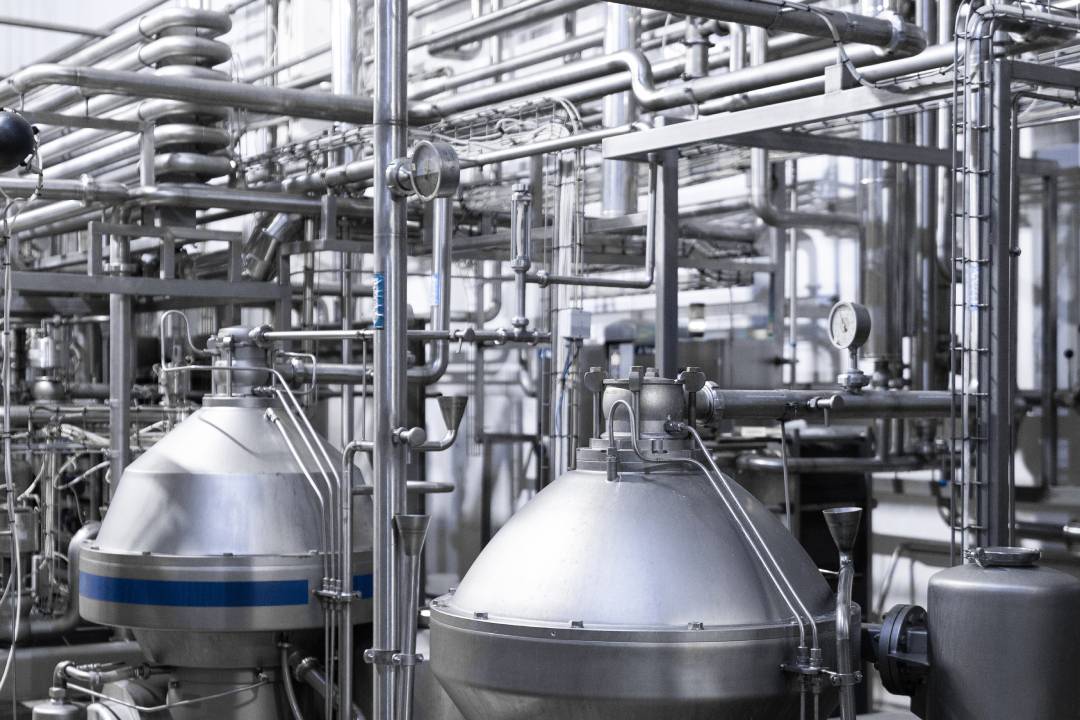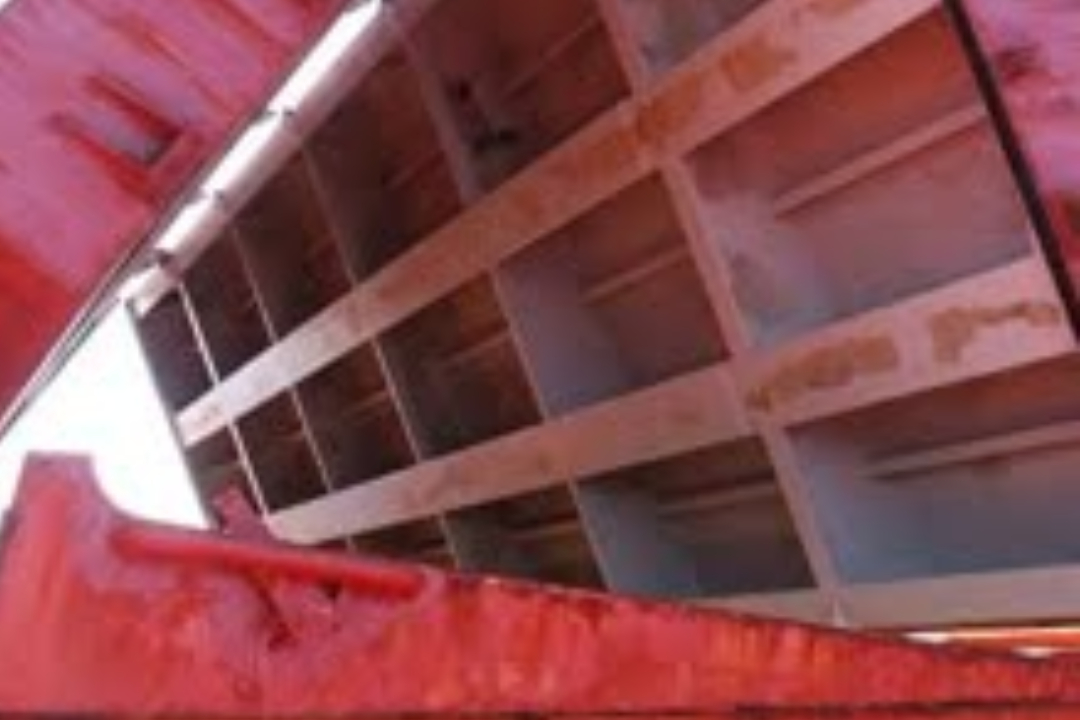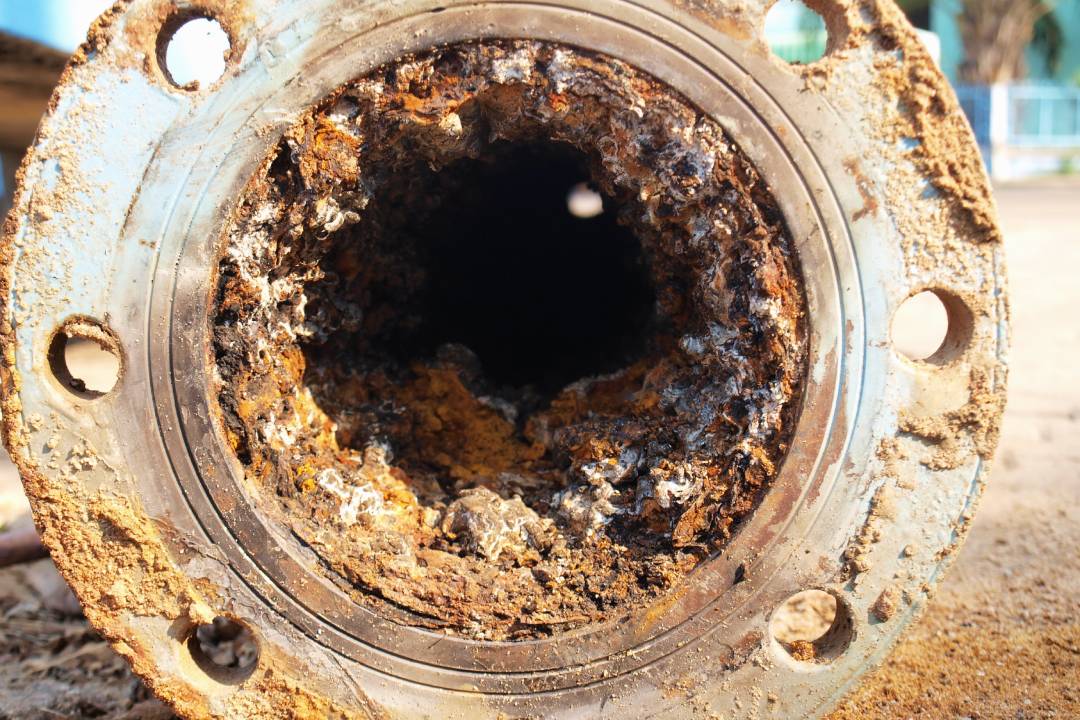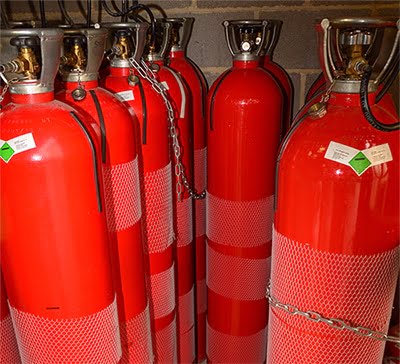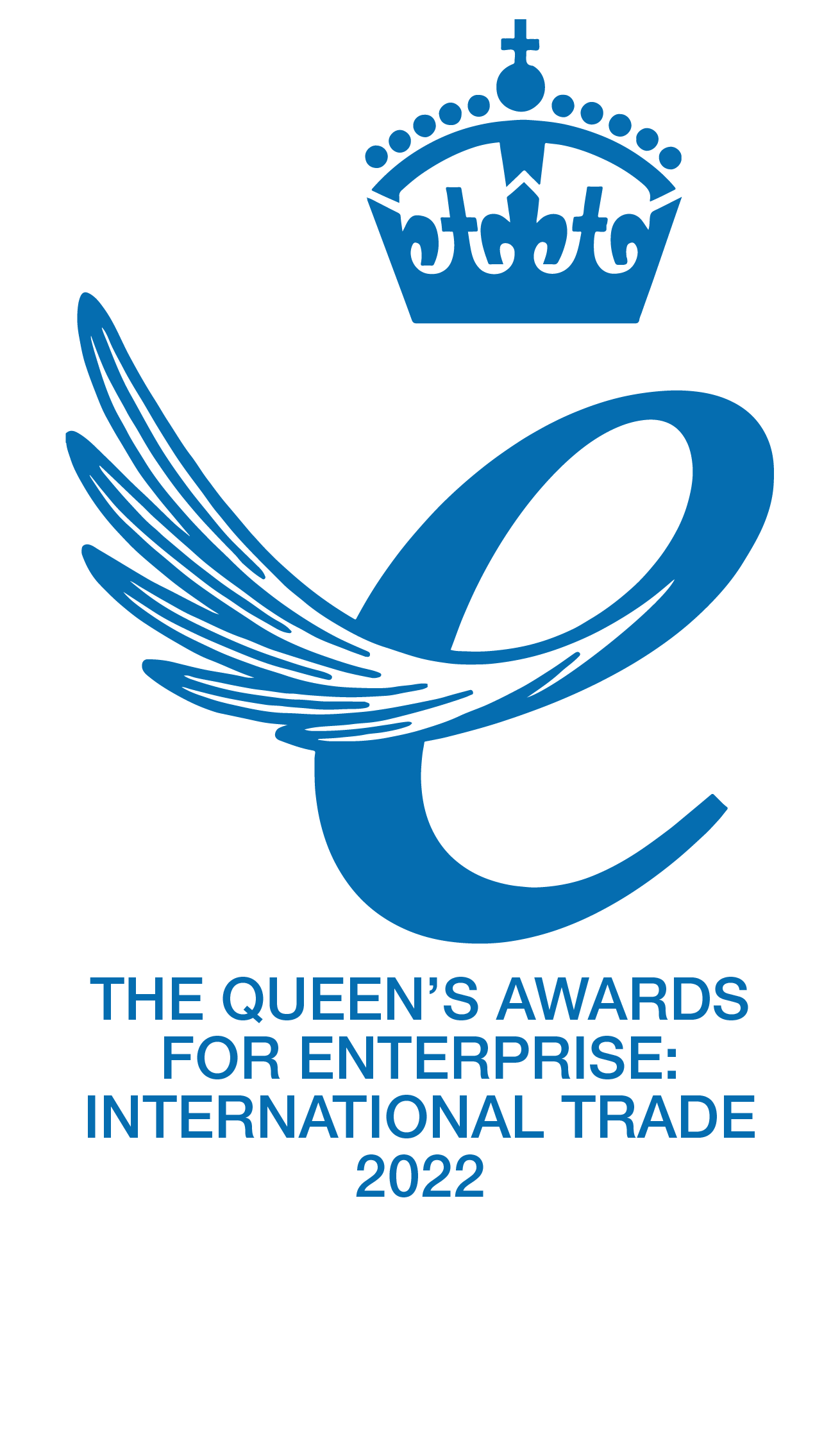Why choose Coltraco Ultrasonics’ range of Ultrasonic Liquid Level Indicators?
Better: Using ultrasonic technology to check the contents of your fire suppression cylinders is non-invasive, non-destructive and non-disruptive meaning it is safer for personnel and does not require the user to shut down the fire suppression system during inspection. The use of ultrasonic technology is a regulatory-approved alternative method for monitoring the contents of cylinders. Our range of ultrasonic liquid level indicators is accurate to ±1.5 mm.
Faster: The non-disruptive, non-invasive nature of ultrasound contents monitoring allows testing to take place when the fire suppression cylinders are in-situ and operational. This process takes around 30 seconds per cylinder using our easy-to-use, intuitive technology. Compare this to traditional, manual weighing which requires lifting equipment, multiple people and around 15 minutes for inspection.
Cheaper; Enabling inspection to take place without disruption to your cylinder installation means no shut-down, saving time and no requirement for multiple operators, saving labour costs. We have a full range of level monitoring technology allowing us to be competitive with pricing and Coltraco Ultrasonics have a “Price Promise” to be the most competitive on the market. For more information and technical support.
Marine Fire Systems and Fire Safety
Coltraco Ultrasonics have over 30 years of experience proudly operating across the maritime industry alongside ship owners, ship managers, marine surveyors, port authorities, shipyards and classification societies. As of 2021, over 20% of the world’s ocean-going vessels use our technology on board. Fire remains the second principal reason for the loss of cargo ships at sea, primarily due to inadequate, or poorly maintained fire suppression systems.
Marine fire suppression systems consist of a group of banked fire cylinders, which are typically high-pressure CO2 and are integral for protecting vital infrastructure, people and assets from damage due to fire. Fire suppression systems are used to extinguish, control and prevent fires from spreading. The majority of fires onboard marine vessels begin in the engine room and machinery spaces, where machinery is operating under pressure and at high temperatures.
Although most marine fire suppression systems contain CO2, we specialise in the monitoring of all types of liquified fire suppression agents, such as CO2, FM-200™, NOVEC™ 1230 (clean agents) and Halons.
“Protecting your marine operations from devastation due to fire at sea”
In the event a fire is detected the centralised monitoring system located in the control room, or bridge will trigger the alert system which activates the fire suppression system. The cylinder valves are opened, and the pressure gauge of the cylinders drives the agent through a pipe network to be discharged at the point of fire. In some cases, these systems are supported by ancillary nitrogen cylinders if the distance the agent needs to travel is great.
Fires onboard ships are not rare events. In fact, fire remains the 2nd principal reason for the loss of ships at sea. When at sea, the crew are required to become firefighters in a fire event, yet this is not their primary role onboard. Ships tend to use fixed CO2 fire suppression systems because it is effective, and CO2 is a cheap agent. Therefore, often fire safety is treated as a tick-box exercise. The danger of CO2 loss is highlighted by Carl Stephen Patrick Hunter, CEO of Coltraco Ultrasonics who has 30 years of experience in the shipping industry and with offshore applications: “We estimate that 20% of ships are sailing with a loss of CO2, due to high pressurisation leakage or accidental discharge. This inevitably means that the design concentration of the CO2 will be insufficient to control fire.”
If the gaseous extinguishing systems are partially empty, due to leakage or discharge, they will not be available in the event of a fire. This is a risk that no shipping company can afford, both with the cost of life and the cost of vessel loss.
The crew, cargo and vessel must be protected when at sea because it is its own fire brigade without accessibility to typical emergency services.
Marine fire systems, like all safety-critical infrastructure, are regulated. Chapter 5 in the IMO SOLAS FSS Code which details how vessels’ fire extinguishing systems should be checked for leaks states that the crew onboard ship are not qualified to undertake CO servicing as it requires the dismantling, weighing and re-installation of the complete system, which must be done by a licensed organisation when the ship is in port. The code states that; “means shall be provided for the crew to safely check the quantity of the fire extinguishing medium in the containers.” To implement the IMO SOLAS FSS code, portable liquid level indicators such as our marine variant Portalevel™ range can be used onboard, allowing the crew to meet the IMO SOLAS code while underway between servicing schedules.
Considering the average ship may have 600 cylinders, and a ship may only be in port for 4 hours, the need for speed is paramount to conduct a rigorous inspection of each cylinder.
Today you can use portable ultrasonic liquid level indicators, the Portalevel® MAX Marine PLUS to check the fill level of the agent takes one person and just 30 second*. If weight is still the preferred result, a calculator can convert the level to weight in 30 seconds by an intuitive tablet app, the Portasteele® CALCULATOR.
Ultrasound & Ultrasonic Liquid Level Operating Principle
All of our liquid-level indicators use ultrasonic sensors to identify the contents of fire suppression cylinders. Ultrasonic sensor technology or Ultrasonic Testing (UT) is a reliable, versatile and safe method for Non-Destructive-Testing (NDT). Ultrasonic waves are sound waves with frequencies above the upper limit of human hearing (above 20 kHz, or 20,000 Hz). Sound waves are mechanical waves that travel in a straight line and require a medium through which to travel. The propagation and attenuation of sound waves depend on the structure of the medium down to an atomic level; therefore, ultrasound is a useful method of studying a material’s structure and the processes occurring within it.
Whilst the highest frequency a human can hear is around 20,000 Hz, Our Portalevel® units are high-frequency ultrasound transmitters that use sound at a frequency of 1,000,000 Hz or 1 MHz. To do this, the main unit sends a strong electrical signal to the sensor (a piezoelectric crystal), which then emits a high energy pulse of ultrasound into the fire cylinder wall through what is known as the reverse piezoelectric effect.
The term ‘piezoelectricity’ has its roots in the Greek word ‘piezein’ (to press) and was discovered in 1880 by Pierre and Paul-Jacques Curie. Piezoelectricity is the appearance of an electrical potential across a crystal when it is subjected to mechanical stress and is a reversible effect. A crystal that exhibits this effect by becoming charged when it is compressed or distorted is a piezoelectric crystal. Similarly, passing electricity through a piezoelectric crystal causes the crystal to vibrate back and forth (producing ultrasound); this is the reverse piezoelectric effect.
The ultrasound that is produced is conducted through the solid walls of the container and then interacts with the contents (CO2, FM™-200, NOVEC™1230, etc.). After the sensor, also known as an ultrasound transducer, stops emitting ultrasound, it starts listening for the returning echoes of the signal. It sends these signals back to the main electronic unit, which then analyses the returning signal in comparison to the calibration signal taken for each cylinder. This allows Coltraco’s range of liquid level indicators to detect the presence or absence of liquid behind the area of the container wall where the sensor is placed without disturbing the contents.
What is the most common fire suppression system used on ships?
The most common fire suppression system used on ships is the CO2 (carbon dioxide) fire suppression system. This system is effective for suppressing fires in engine rooms, machinery spaces, and cargo holds. CO2 is discharged as a gas, displacing oxygen and suffocating the fire. It is preferred for marine applications due to its effectiveness, non-corrosive properties, and ability to quickly suppress fires without leaving residue. Additionally, CO2 is stored in high-pressure cylinders and can be remotely activated from a control panel, making it suitable for use in confined spaces and critical areas of a ship.
What are the different fire fighting systems on ships?
Fire fighting systems on ships typically include a range of equipment and systems to combat fires at sea. These may include fire pumps, fire hoses, fire extinguishers, fire alarms, fixed firefighting systems (such as CO2 or foam systems for engine rooms), and portable fire fighting equipment. These systems are crucial for ensuring the safety of the vessel, crew, and cargo in case of a fire emergency.
What are the 5 types of special suppression systems?
The five types of special suppression systems commonly used are:
- Carbon Dioxide (CO2) suppression systems
- Foam suppression systems
- Dry chemical suppression systems
- Water mist suppression systems
- Clean agent suppression systems (such as FM-200 or Novec 1230)
Each type of suppression system has its specific applications and effectiveness in suppressing fires based on the type of fuel involved and the specific requirements of the protected area.
What is the difference between a fire fighting system and fire suppression system?
The primary difference between a fire fighting system and a fire suppression system lies in their approach to combating fires. A fire fighting system typically refers to the equipment and systems used to actively fight fires, such as fire pumps, hoses, and firefighting agents like water or foam. On the other hand, a fire suppression system is designed to automatically suppress or extinguish fires through fixed systems, such as sprinklers, gas-based suppression systems, or chemical agents.
What is the difference between a wet and dry fire suppression system?
The difference between a wet and dry fire suppression system lies in the type of agent used for suppression. In a wet fire suppression system, water is the primary extinguishing agent. It is stored in pipes and released when triggered by heat or a fire alarm. In contrast, a dry fire suppression system utilises substances other than water, such as gases (CO2, FM-200) or dry chemical agents (powder), to suppress fires. These agents work by displacing oxygen or chemically inhibiting the combustion process.
What is the difference between a water pump and a fire fighting pump?
The main difference between a water pump and a fire fighting pump lies in their intended purpose and design. A water pump is a general-purpose pump used for various applications, such as moving water from one location to another for irrigation or domestic use. A fire fighting pump, however, is specifically designed for fire suppression and is capable of delivering high-pressure water flow to extinguish fires effectively. Fire fighting pumps are built to meet specific standards and requirements, including the ability to generate sufficient pressure and volume of water for firefighting purposes.
What gas is used in fire suppression systems?
Various gases are used in fire suppression systems, depending on the specific application and the type of fire being suppressed. Some commonly used gases include:
- Carbon Dioxide (CO2): It is effective for suppressing fires by displacing oxygen, thus reducing the fire’s ability to sustain combustion.
- FM-200: A clean agent gas that extinguishes fires by removing heat from the fire triangle.
- Novec 1230: Another clean agent gas that works by removing heat and interrupting the fire chain reaction.
- Inert gases (such as Argon, Nitrogen, and Inergen): These gases reduce oxygen levels in enclosed spaces, inhibiting the combustion process.
The selection of the appropriate gas depends on factors such as the type of fire hazard, the protected area’s size, and any environmental considerations.
Are sprinklers considered fire suppression?
Yes, sprinklers are considered a form of fire suppression. Automatic sprinkler systems are commonly used as a primary fire suppression method in buildings and other structures. Sprinklers are designed to detect heat from a fire and automatically release water, suppressing or extinguishing the fire before it spreads. They are highly effective in controlling fires, preventing their rapid escalation, and providing additional time for evacuation and firefighting efforts.
However, sprinkler systems are not commonly employed on ships due to a variety of factors. Firstly, ships are in constant motion, which poses challenges for stationary sprinkler systems to effectively cover different areas. Additionally, the marine environment is prone to corrosion, potentially compromising the functionality of sprinkler components over time. Ensuring a reliable water supply for sprinklers on ships, particularly during emergencies, can be difficult. Moreover, the weight and space constraints inherent to ships make it impractical to install large sprinkler systems. Instead, ships often rely on specialized fire suppression systems like CO2, foam, or water mist, which are better suited to maritime environments and firefighting requirements.






